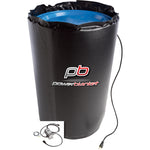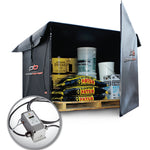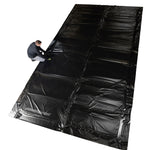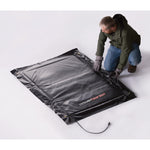You have no items in your shopping cart.
Article At-a-Glance
Can Roof Repairs Be Done in Winter?
Yes, roof repairs can be effectively and safely performed in winter using specialized tools like bulk material warmers and heated blankets to maintain material pliability and ensure a safe working environment despite the cold conditions.
Key Takeaways
- Winter Roof Repairs Are Possible: With the right tools and techniques, roof repairs can be safely and effectively conducted during winter, even in freezing temperatures.
- Essential Tools for Cold Weather: Utilize specialized equipment like bulk material warmers, bucket heaters, and caulk warming pouches to keep roofing materials pliable and adhesives workable in cold conditions.
- Safety Precautions Are Crucial: Ensure a safe working environment by using heated blankets to melt ice and snow, and always wear appropriate safety gear, including harnesses and fall protection.
- Challenges of Winter Roofing: Cold weather can make materials brittle and difficult to work with, but using the right heating solutions can mitigate these issues and prevent further damage.
- DIY and Professional Guidance: Whether you're a DIY enthusiast or a professional, understanding the risks and having the right equipment is key to successfully managing roof repairs in winter.
Beating the Freeze: Essential Tools for Efficient Roof Repair in Cold Weather
Winter roofing projects don’t have to be dangerous or difficult. With the right heating equipment, roof replacement or repair can still happen in cold weather. This article will explore the challenges of winter roofing, highlight essential tools like bulk material warmers, bucket heaters, and caulk warming pouches, and provide valuable tips for both professionals and DIYers.
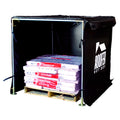
$3,303.99 USD
64 CU/FT Roofer Bulk Material Warmer (12 Amp, 120V)
For efficient heating solutions to keep materials warm during cold-weather roofing, consider using Heat Authority's Bulk Material Heaters. These heaters make it possible to maintain optimal temperatures for adhesives, shingles, and caulking products in freezing weather.
The Challenges of Winter Roof Repair
Roof repair and replacement can be a daunting task at any time of year. It’s expensive. It’s time-consuming. And without the right equipment, it can be dangerous. However, the challenges are amplified in the winter when plummeting temperatures can ruin roofing materials and increase safety risks for workers. Fortunately, with the right tools and techniques, it is possible to successfully and safely complete roofing projects even in harsh winter conditions.
What Time of Year Is Best for Roof Repairs?
The ideal time for roof repairs is typically during the spring or fall when temperatures are mild and the risk of precipitation is lower. However, if a roof leak or other damage poses a safety hazard, repairs may need to be carried out in the winter.

Is It OK to Reroof in Winter?
Though cold temperatures can increase safety risks, the right equipment can make it possible to conduct winter roofing projects. Contractors must take extra precautions to ensure the safety of workers and the quality of the installation.
Can You Repair a Roof Leak in the Winter?
Repairing a roof leak in the winter isn’t easy. Ice and snow can obscure the source of leaks, making it difficult to identify and address problems. The challenges and solutions for winter roofing can also vary depending on the type of roof. For example, flat roofs may be more susceptible to ice dams, while shingle roofs may be prone to cracking in cold temperatures. In fact, these same low temperatures can have a serious negative impact on your roofing repair materials.
Keeping Materials Workable in the Cold
Cold temperatures can cause shingles to become brittle and crack, making them more susceptible to leaking. In these conditions, glues and adhesives can thicken beyond the point of use, and sealants won’t seal properly when applied to extremely cold surfaces. However, heating equipment built for cold weather allows you to keep moving forward with your winter roofing projects.
For example, roofer’s bulk material warmers prevent shingle brittleness by keeping shingles warm and pliable using evenly-spread heating elements inside of a durable vinyl cover.
Industrial-grade warmers can also protect roofing adhesive, allowing for bonding and sealing materials like caulk to maintain proper viscosity for effective bonding, even in frigid temperatures. Caulk is essential for creating a watertight seal around flashings, vents, and other roof penetrations. Caulk warming pouches can help to prevent caulk from becoming too thick and difficult to apply, ensuring a high-quality seal that will hold up as the weather warms and snow and ice melt away. Other warmers such as heaters for large totes allow entire pallets of caulking products to be kept pliable even in freezing conditions.

Winter Roofing Safety
Safety is paramount when working on a roof in the winter. If required, always wear appropriate safety gear, including a harness and fall protection. Additionally, make sure you have a clear, non-slip working environment both on the roof and around the project area.
Heavy snow and thick ice can take months to thaw, delaying projects until the weather warms enough to melt them naturally. However, heated blankets can be used to melt ice and snow in as little as a few hours, creating a safer working environment without having to wait until spring.
Essential Tools for Winter Roofing
- Bulk Material Warmers: These heaters for large totes are designed to keep roofing materials like shingles warm and pliable, preventing them from becoming brittle and cracking.
- Bucket Heaters: Bucket heaters maintain the ideal temperature for roofing adhesives, ensuring they remain workable in cold conditions.
- Caulk Warming Pouches: These pouches can be used to heat caulk, preventing it from becoming too thick and difficult to apply.
- Heated Blankets: Heated blankets can be used to melt ice and snow on the roof, creating a safer working environment.

Caulk pouch heaters are easy to carry up onto the roof itself for quick access to usable caulk.
DIY Tips for Winter Roofing
If you are considering tackling a DIY roof repair project in the winter, it is essential to have a thorough understanding of the risks involved. Powerblanket products can be invaluable tools for contractors and DIYers alike, providing heat and insulation to help ensure a safe and successful project.
Conclusion
Winter roofing presents unique challenges that require careful planning and the use of appropriate tools. By understanding the risks and taking the necessary precautions, it is possible to successfully complete roof repair and replacement projects even in the coldest weather. If you're looking for an efficient way to heat large quantities of material, look no further than Heat Authority's Bulk Material Heaters.







